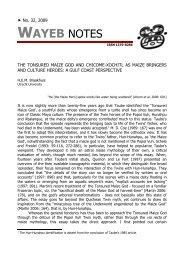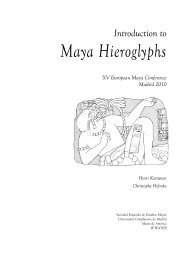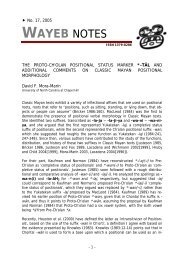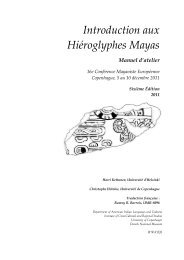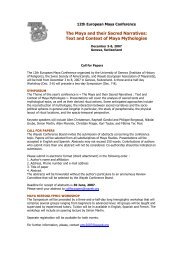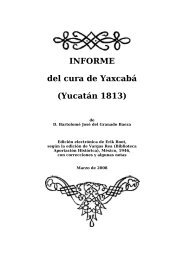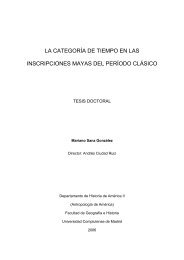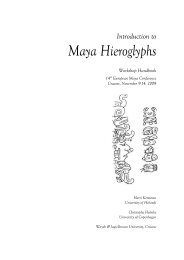Introduction to Maya Hieroglyphs - Wayeb
Introduction to Maya Hieroglyphs - Wayeb
Introduction to Maya Hieroglyphs - Wayeb
Create successful ePaper yourself
Turn your PDF publications into a flip-book with our unique Google optimized e-Paper software.
Kettunen & Helmke 2011<br />
<strong>Introduction</strong><br />
1. HISTORY OF DECIPHERMENT<br />
The his<strong>to</strong>ry of the decipherment of the <strong>Maya</strong> script is an intriguing account, nearly 500 years in duration, wherein<br />
a functional understanding of the writing system was pursued, a system that at a first glance looks as alien as can<br />
possibly be imagined. It is impossible <strong>to</strong> relate even the basic features of these his<strong>to</strong>ries in this volume, but some<br />
outlines of the most important discoveries should be mentioned in order for the reader <strong>to</strong> be able <strong>to</strong> comprehend<br />
how some of the readings came about.<br />
In 1862, while looking for New World research material at the Royal Academy of His<strong>to</strong>ry in Madrid, a French<br />
clergyman by the name of Charles Étienne Brasseur de Bourbourg came upon a manuscript titled Relación de las<br />
cosas de Yucatán 7 written by a bishop Diego de Landa. Two years later, Brasseur de Bourbourg published the<br />
manuscript as a bilingual edition (Spanish and French) by the name of Relation des choses de Yucatán de Diego de<br />
Landa.<br />
Three decades prior, American lawyer and travel writer John Lloyd Stephens set off<br />
with English artist Frederick Catherwood, from New York <strong>to</strong> travel <strong>to</strong> the <strong>Maya</strong> area<br />
via Belize. During their annual sojourns between 1839 and 1842, they explored<br />
ruined <strong>Maya</strong> sites, wrote reports, drafted maps and sketched ancient sculptures and<br />
buildings. Through their efforts they made the “lost cities” of the <strong>Maya</strong> known for<br />
the general audience in two lavishly illustrated volumes: Incidents of Travel in Central<br />
America, Chiapas, and Yucatan (1841) and Incidents of Travel in Yucatan (1843). In the<br />
first of these volumes Stephens wrote of Copan:<br />
In regard <strong>to</strong> the age of this desolate city I shall not at present offer any conjecture. Some idea<br />
might perhaps be formed from the accumulations of earth and the gigantic trees growing on the<br />
<strong>to</strong>p of the ruined structures, but it would be uncertain and unsatisfac<strong>to</strong>ry. Nor shall I at this<br />
moment offer any conjecture in regard <strong>to</strong> the people who built it, or <strong>to</strong> the time when or the<br />
means by which it was depopulated, and became a desolation and ruin; whether it fell by the<br />
sword, or famine, or pestilence. The trees which shroud it may have sprung from the blood of<br />
its slaughtered inhabitants; they may have perished howling with hunger; or pestilence, like<br />
the cholera, may have piled its streets with dead, and driven forever the feeble remnants from<br />
their homes; of which dire calamities <strong>to</strong> other cities we have authentic accounts, in eras both<br />
prior and subsequent <strong>to</strong> the discovery of the country by the Spaniards. One thing I believe,<br />
that its his<strong>to</strong>ry is graven on its monuments. Who shall read them? (Stephens 1993 [1841]:<br />
59).<br />
Figure 1: Stela A, Copan, Honduras<br />
(drawing by Frederick Catherwood)<br />
This challenge was probably put forward by Stephens in view of the fact that<br />
the Egyptian script had been cracked (by Jean-François Champollion) just<br />
decades prior <strong>to</strong> the publication of his book. However, during Stephen’s times<br />
there was no Rosetta s<strong>to</strong>ne 8 available for the still nascent <strong>Maya</strong> studies. After<br />
the discovery of Landa’s Relación by Brasseur de Bourbourg, the scholars thought<br />
they had the Rosetta s<strong>to</strong>ne of <strong>Maya</strong> studies at their disposal.<br />
In one of the pages Landa describes what he thought were <strong>Maya</strong> alphabetic<br />
characters. The so-called Landa alphabet (see Figure 28) was just about instantly<br />
condemned <strong>to</strong> be a misunderstanding by this Spanish clergyman (which it was –<br />
<strong>to</strong> a certain point at least). Thus, it was assumed that this ‘alphabet’ was useless.<br />
Consequently, no correlation or academic examination worthy of consideration<br />
were completed during the following hundred years.<br />
One of the problems was that both Landa and the scholars of the late<br />
19 th century, up <strong>to</strong> those of the 1950’s, failed <strong>to</strong> understand that the<br />
<strong>Maya</strong> script was not alphabetic or solely phonetic (or merely<br />
logographic for that matter) 9 . At first scholars tried <strong>to</strong> apply the Landa alphabet directly (but, time and again,<br />
unsuccessfully) <strong>to</strong> the <strong>Maya</strong> script. On the other hand – at around the same time – the logograms for calendrical<br />
7<br />
The manuscript is actually an abridgement of the original by Diego de Landa Calderón, written around 1566 in Spain, but never recovered since.<br />
This abridgement proceeded from one copyist <strong>to</strong> another until a later version (written around 1660) was uncovered by Brasseur de Bourbourg.<br />
8<br />
The Rosetta s<strong>to</strong>ne was discovered in 1798 during the intrusion of the Napoleonic army in Egypt. It contained three parallel texts in Greek,<br />
demotic Egyptian, and hieroglyphic Egyptian. The proper names in the parallel texts were the basis for cracking the Egyptian hieroglyphs.<br />
9/154



